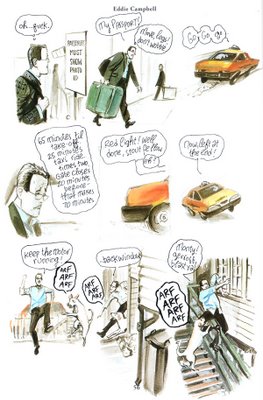 The Reader got up one morning and realized that there was a new Eddie Campbell book that he had picked up a few weeks ago and didn't get around to reading for various reasons. He'd been reading Campbell comics for almost two decades, which is nothing compared to how long Campbell had been creating them, but still a long time. This newest book was both a departure and a continuation for Campbell. It was in a direct line from his long-running autobiographical work, which had begun as the veiled autobiographical "Alec" stories, and lost the veil in the books HOW TO BE AN ARTIST and AFTER THE SNOOTER. This book, though, was quite different. Full colour for the first time. Created as a complete book rather than a collection of short stories. Published by a mainstream publisher with wide distribution for the first time (the Reader had actually seen big stacks of it in several bookstores).
The Reader got up one morning and realized that there was a new Eddie Campbell book that he had picked up a few weeks ago and didn't get around to reading for various reasons. He'd been reading Campbell comics for almost two decades, which is nothing compared to how long Campbell had been creating them, but still a long time. This newest book was both a departure and a continuation for Campbell. It was in a direct line from his long-running autobiographical work, which had begun as the veiled autobiographical "Alec" stories, and lost the veil in the books HOW TO BE AN ARTIST and AFTER THE SNOOTER. This book, though, was quite different. Full colour for the first time. Created as a complete book rather than a collection of short stories. Published by a mainstream publisher with wide distribution for the first time (the Reader had actually seen big stacks of it in several bookstores).So it was kind of a disappointment to the Reader when he finally got around to reading the new book. Oh, he liked it well enough, but it didn't hold a candle to the books in its lineage, in particular the original Alec stories and the brilliant AFTER THE SNOOTER (the Reader wasn't as big a fan of HOW TO BE AN ARTIST, but it was still better than the new book). Parts of it, the bits told in traditional Campbellian comics form (only now with colour) were up to the Reader's opinion of the earlier stuff, but a lot of the book plays with a few other forms. A short bit narrated by photos of Campbell's daughter talking about Campbell. Several pages of fake comic strips interspersed with vague allegorical connections to the main story. Several bits of straight text with a few illustrations. Those didn't work as well for the Reader...
This third person stuff is kind of awkward to write, and probably worse to read. I'll stop now. Anyway, I wish I could be more enthusiastic about this book. The parts of it I liked, which amount to about half the book, I liked a lot. Even the other parts I could, for the most part, at least see what Campbell was doing and appreciate the effort, even though I think those bits would have been more effective as straight comics (the fake comic strip bits I really didn't like at all, and I think whatever point they had flew right by me). Maybe I'm just an old fogey, but a lot of the time experimentalism like that just doesn't appeal to me when what I want is straight comics.
I don't want to sound too down on the book, since I do still recommend picking it up. A lot of it works well, and I can't really blame Campbell for setting the bar so high with his earlier work, even if I wished some of that work got the attention this one did. I'm looking forward to seeing what he does next.

I think the main problem with your ability to accept this newer work may lie in your definement of "straight comics," a demarkation which Campbell refuses to make.
ReplyDeleteProbably. I do confess to being an old fogey, and I did disagree with some bits of Campbell's analysis of such issues back in HOW TO BE AN ARTIST. Anyway, I've decided to re-read all the old Alec and post-Alec stuff over the next little while, leading up to this book, and then re-read this to see how it works in that context.
ReplyDelete